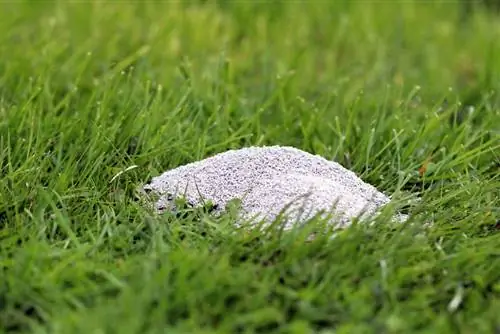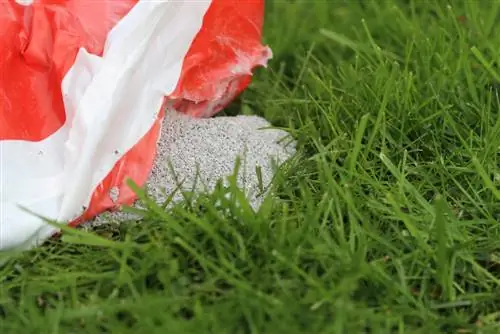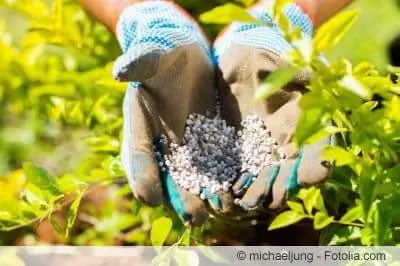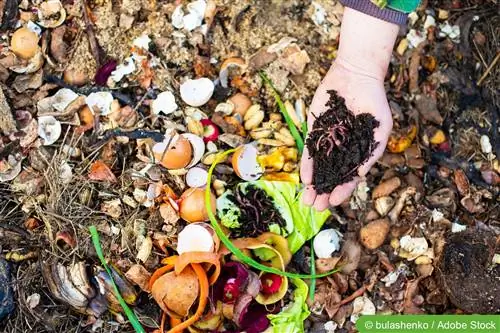- Author admin [email protected].
- Public 2023-12-17 03:39.
- Last modified 2025-01-24 12:45.
In order to prepare the trees, bushes and perennial plants well for winter, fertilization should definitely be carried out regularly in autumn. Autumn fertilization makes sense, especially for a lawn. In this way, the plants that have to prepare for a frosty winter are strengthened and can therefore better survive very low temperatures, especially if they are evergreen shrubs and plants. The potassium content in autumn fertilizer increases the s alt content in the cell sap of the individual plants and allows them to better withstand frost.
Why fertilize in autumn?
Even in winter, evergreen plants and bushes such as rhododendrons, boxwood or evergreen perennials need special protection from the inside, which gives them the resistance to survive a frosty winter unscathed. The lawn and other ornamental grasses should not be forgotten when fertilizing in the fall. Normally the plants get the nutrients they need from the soil themselves.
In a tidy garden, however, where the falling leaves are gathered up in autumn and fallen fruit is collected, new nutrients are usually no longer added to the existing soil and outside help is required.
The mixtures available in stores for autumn primarily contain a lot of potassium. This has the effect that the cell sap of the individual plants increases the s alt content. This lowers the freezing point of the cell sap and makes the cells much more resistant to very low temperatures. But not only is the frost hardiness of the plants fertilized in autumn increased, autumn fertilization also results in further positive developments within the individual plants:
- Potassium has other positive effects on plants
- the water pressure in the root is increased
- this improves gas exchange and water transport
- the stomata opening is improved in the leaves
- this allows more regulated evaporation to occur
- the water flow in the plant remains more even in this way
- Carbon dioxide can be better absorbed by the leaves for photosynthesis
- especially a snow-covered lawn is better protected this way
- especially if it is accessed frequently
- plenty of flowers next year is also guaranteed
Tip:
Through autumn fertilization, every plant becomes more resistant to the adversities of winter, which include not only frost and cold, but also less sunlight and more dark hours.
The right time
The right time for autumn fertilization must be chosen carefully. If fertilization is carried out too late, it may well be that the soil can no longer absorb the nutrients supplied to it and therefore no longer be able to pass them on to the plants. If mineral fertilizers are used, if applied too late, they could only be washed out throughout the winter and hardly reach the plants.
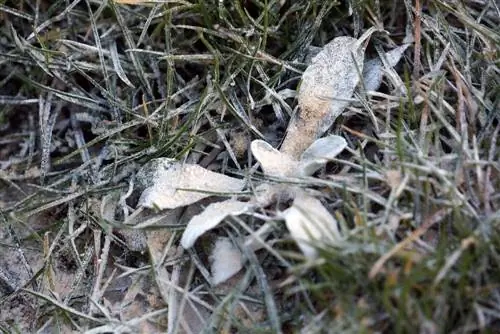
The first two weeks of September is the ideal time to fertilize shrubs, trees and other hardy plants. A lawn, on the other hand, can receive its last fertilization in late autumn at the end of October.
Tip:
If you leave the garden natural, you can do without autumn fertilizer. However, this also means that no plant remains of vegetables or flowers, grass clippings or falling leaves and fruits may be removed. In this way, the nutrients from the plant parts that decompose on the ground reach directly into the soil. Unfortunately, this way the garden looks a little “messy”.
How should I fertilize?
The question here is how to apply autumn fertilizer correctly to get the best possible result. Summers are often very hot and dry, so the garden soil must be prepared first for good fertilization results. Because even if watering was carried out more often during such hot periods, the soil is still very dry, especially in the lower areas. Therefore, precautions must be taken first before autumn fertilizer can be applied:
- water the entire area to be fertilized well
- this should happen over several days
- If the soil is too dry when fertilization occurs, it cannot be absorbed
- Fertilizer stays above the ground
- it will be washed away in the next longer period of rain
- if the soil is wet enough, it is fertilized
- Compost is lifted under
- pay attention to the manufacturer's instructions when buying commercial fertilizers
- there are liquid fertilizers that are administered with the irrigation water
- granular and powdery fertilizers are scattered throughout the area
The suitable fertilizer
There are various fertilizers that are suitable as autumn fertilizer. However, it is important for all of them that they contain the potassium the plants need in winter. There is a large range of autumn fertilizers available from retailers and you can also use self-made fertilizer here. The most important question here, however, is whether organic fertilizer or mineral fertilizer should be used. In addition to some commercially available fertilizers, organic fertilizers also include home-made compost fertilizer.
However, if you decide to use compost, the preparation must be done the year before. The main advantage of compost fertilizer and also the organic fertilizer that is available commercially is that it does not require any chemical additives. This fertilizer also has the advantage that it is not washed out; the microorganisms that are not absorbed by the plants before winter remain in the soil until they are needed again in spring. Because they occur naturally, they can adapt to climatic conditions. If you still decide to use mineral fertilizer from the trade, you should consider the following points:
- Composition is very important
- Potassium should be included
- Nitrogen-based fertilizer is not recommended for autumn
- this drives the plant to grow
- it also washes out quicker
- If there is a lot of rain in winter, nitrate gets into the groundwater
Tip:
If mineral fertilizer is used, burns can occur on the roots of the plants due to too high a dosage or too late fertilization. Therefore, you must always pay close attention to the manufacturer's instructions with these chemically produced fertilizers.
Make your own compost
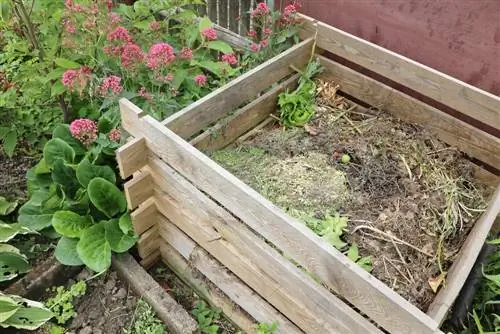
Ideally, the autumn garden is also fertilized in such a way that the natural conditions are met. Compost is a suitable fertilizer not only for spring and summer, but also for autumn. In the wild, in autumn, plants also feed on what naturally falls to the ground, decomposes and then enters the earth with rainwater. Although this is a slightly longer process, it is also very effective due to the natural environment. A well-stocked garden should not be missing a compost that preserves this naturalness. In addition, it was prepared in advance; the plant parts have already decomposed and are mixed into the garden soil around the plants. This accelerates the natural process and the plants can absorb the nutrients immediately. The following explains how to create the compost correctly:
- Get a box for compost from a well-stocked garden store
- put in a corner in the garden
- far away from the terrace and seating area due to odor formation
- All garden waste generated throughout the year is disposed of here
- Shred the branches first
- Let the lawn clippings dry beforehand
- otherwise the compost will be too wet and can rot
- the leaves should also dry beforehand
- Coffee grounds can also be disposed of in the compost
- After about half a year the compost can be used
Tip:
Homemade compost is particularly suitable for garden beds where it can be carefully dug into the ground between individual plants and under bushes or trees. A layer of mulch also helps here after adding compost. Fertilizer powder, on the other hand, is well suited for a lawn because it is simply sprinkled on.
Conclusion
A natural garden in which not all plant parts, leaves, grass clippings and fallen fruit are removed is still the best autumn fertilization for the beds. If you prefer things tidy, create a compost heap. All the waste that the garden produces comes into this place throughout the year and can then be recycled in the fall. If you have less time, you can buy organic or mineral fertilizer from stores. This has the advantage that the fertilizer purchased is offered in liquid, granular or powdered form and therefore does not have to be added into the soil, as is the case with the compost you make yourself. Otherwise, when buying, you should always make sure that the autumn fertilizer contains potassium, as this is needed by the plants at this time of year.

